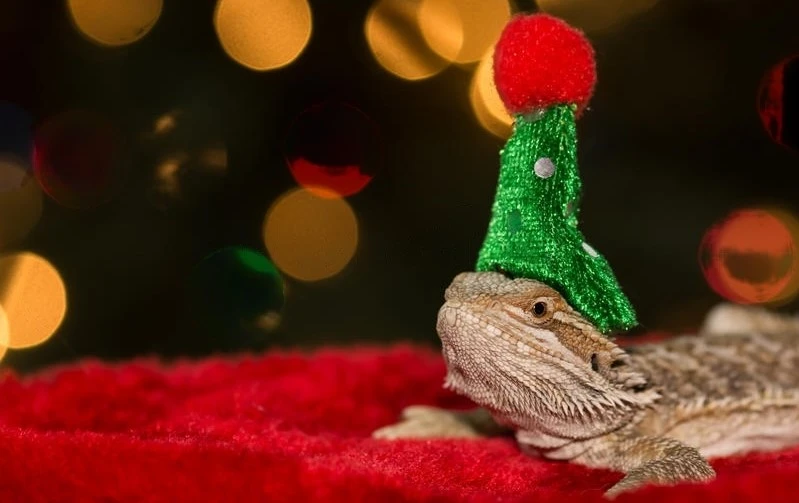Bearded dragons are majestic and mysterious creatures. While they may appear to be quiet, docile animals, their subtle signs of good health can tell us a lot about the state of their well-being.
All bearded dragons have some common traits when it comes to displaying good health: bright eyes, alert posture, vibrant colors, and more.
But beyond that lies a world of small details that give us insight into our scaly friends’ overall condition. By paying attention to even the smallest changes in behavior or appearance, we can gain valuable information about how our bearded dragon is doing at any given moment.
So come along with me on this journey as I share my experience analyzing the signs of a healthy bearded dragon!
Alert And Energetic
A healthy bearded dragon will be alert and active. They’ll act curious, exploring around their environment and checking out new things.
Bearded dragons are great climbers and love to bask in the sun, so look for them climbing branches or rocks when they’re feeling good. If you see your beardie walking about with pep in its step, that’s a sure sign of a happy, healthy dragon!
Bearded dragons can also exhibit different behaviors depending on their moods. A contented one may “arm wave” by extending an arm while wiggling it back and forth as if waving hello. Or they might bob their head in greeting or show pleasure by licking objects like stones or glass. These signs mean they’re doing well and enjoying life.
It’s important to keep an eye out for any potential changes in behavior since this could indicate something is wrong health-wise.
Good Posture
Healthy bearded dragons display good posture. When standing upright, their tails should be held high. If lying down or curled up, all of the dragon’s limbs should be neatly tucked beneath their bodies. They should never be hunched over at any time. They should always point outward and not inward. This shows that they are relaxed, but still aware of their surroundings.
It’s also important to note that if your beardie has poor posture due to age, illness, or injury it is important to seek veterinary care right away as this can indicate underlying health issues.
Poor posture could mean that the dragon isn’t able to stand correctly due to a lack of muscle strength or joint pain from arthritis for example.
Beardies who feel secure in their environment will often lift themselves off the ground with both front arms while shaking their body back and forth slightly on each side!
It’s an endearing behavior that can give you insight into how happy your pet may be feeling inside its home.
Healthy Appearance

A healthy bearded dragon looks like a living piece of art, with each scale as finely detailed as an elegant tapestry.
The reptile’s body should be bright and vibrant in coloration, with its spikes standing erect and proud along its back.
When observing the bearded dragon from above, you’ll notice:
- Their eyes are deep-set and alert
- Their pupils are jet black
- A strong jawline for eating food easily
- An even-looking belly that is free of lumps or bumps
Skin and Scales
The skin of a healthy bearded dragon should be smooth and free of bumps, cuts, or dry patches. Their scales should be flat, tightly attached to the skin, and without shedding.
Eyes
A healthy bearded dragon’s eyes should be bright and clear with no discharge or swelling. The pupils should be equal in size and responsive to light.
Limbs
Healthy bearded dragons have solid and sturdy limbs. They should be able to move around freely without any signs of pain or discomfort.
Tail
A healthy bearded dragon’s tail should be thick, full, and free of any kinks or breaks. The tail is an essential part of the bearded dragon’s body as it stores fat and water.
Healthy Eating Habits

Bearded dragons are omnivores, meaning they eat both plants and animals. A healthy bearded dragon should have a good appetite and show interest in food.
Appetite
Bearded dragons have a voracious appetite and should eat daily. If your pet shows a sudden loss of appetite, it may be a sign of illness. A healthy bearded dragon should also show interest in a variety of food items.
Hydration
Proper hydration is essential for a healthy bearded dragon. They require a shallow dish of clean water in their enclosure, and some may prefer to drink water droplets from plants. Dehydration is a severe condition that can lead to a host of health problems.
Regular Bowel Movements
A healthy bearded dragon should have regular bowel movements. Their stool should be firm and moist, and they should defecate daily. If your pet has not defecated in several days, it may indicate illness.
Conclusion
As a pet owner, it is important to be aware of the signs that indicate your bearded dragon’s health. An alert and energetic demeanor will demonstrate that they are feeling their best.
Furthermore, good posture indicates that your beardie has plenty of strength and vitality in its body.
Finally, look at the appearance of your bearded dragon for clues about their overall health – well-fed dragons should have thick tails and deep hues on their scales.
When these three key indicators are present, you can rest assured knowing that your pet is in top condition.
With regular vet checkups and proper care, there’s no reason why you shouldn’t enjoy many years with your beloved bearded dragon companion.
